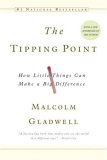Summary | Excerpt | Reviews | Readalikes | Genres & Themes | Author Bio

Critics' Opinion:
Readers' Opinion:
First Published:
Feb 2000, 279 pages
Paperback:
Dec 2001, 304 pages
The second, and perhaps more interesting, fact about these explanations is that all of them are describing a very different way of tipping an epidemic. The CDC is talking about the overall context for the disease — how the introduction and growth of an addictive drug can so change the environment of a city that it can cause a disease to tip. Zenilman is talking about the disease itself. When the clinics were cut back, syphilis was given a second life. It had been an acute infection. It was now a chronic infection. It had become a lingering problem that stayed around for weeks. Potterat, for his part, was focused on the people who were carrying syphilis. Syphilis, he was saying, was a disease carried by a certain kind of person in Baltimore — a very poor, probably drug-using, sexually active individual. If that kind of person was suddenly transported from his or her old neighborhood to a new one — to a new part of town, where syphilis had never been a problem before — the disease would have an opportunity to tip.
There is more than one way to tip an epidemic, in other words. Epidemics are a function of the people who transmit infectious agents, the infectious agent itself, and the environment in which the infectious agent is operating. And when an epidemic tips, when it is jolted out of equilibrium, it tips because something has happened, some change has occurred in one (or two or three) of those areas. These three agents of change I call the Law of the Few, the Stickiness Factor, and the Power of Context.
1
When we say that a handful of East Village kids started the Hush Puppies epidemic, or that the scattering of the residents of a few housing projects was sufficient to start Baltimore's syphilis epidemic, what we are really saying is that in a given process or system some people matter more than others. This is not, on the face of it, a particularly radical notion. Economists often talk about the 80/20 Principle, which is the idea that in any situation roughly 80 percent of the "work" will be done by 20 percent of the participants. In most societies, 20 percent of criminals commit 80 percent of crimes. Twenty percent of motorists cause 80 percent of all accidents. Twenty percent of beer drinkers drink 80 percent of all beer. When it comes to epidemics, though, this disproportionality becomes even more extreme: a tiny percentage of people do the majority of the work.
Potterat, for example, once did an analysis of a gonorrhea epidemic in Colorado Springs, Colorado, looking at everyone who came to a public health clinic for treatment of the disease over the space of six months. He found that about half of all the cases came, essentially, from four neighborhoods representing about 6 percent of the geographic area of the city. Half of those in that 6 percent, in turn, were socializing in the same six bars. Potterat then interviewed 768 people in that tiny subgroup and found that 600 of them either didn't give gonorrhea to anyone else or gave it to only one other person. These people he called nontransmitters. The ones causing the epidemic to grow — the ones who were infecting two and three and four and five others with their disease — were the remaining 168. In other words, in all of the city of Colorado Springs — a town of well in excess of 100,000 people — the epidemic of gonorrhea tipped because of the activities of 168 people living in four small neighborhoods and basically frequenting the same six bars.
Who were those 168 people? They aren't like you or me. They are people who go out every night, people who have vastly more sexual partners than the norm, people whose lives and behavior are well outside of the ordinary. In the mid-1990s, for example, in the pool halls and roller-skating rinks of East St. Louis, Missouri, there was a man named Darnell "Boss Man" McGee. He was big — over six feet — and charming, a talented skater, who wowed young girls with his exploits on the rink. His specialty was thirteen- and fourteen-year-olds. He bought them jewelry, took them for rides in his Cadillac, got them high on crack, and had sex with them. Between 1995 and 1997, when he was shot dead by an unknown assailant, he slept with at least 100 women and — it turned out later — infected at least 30 of them with HIV.
© 2000 by Malcolm Gladwell





The House on Biscayne Bay
by Chanel Cleeton
As death stalks a gothic mansion in Miami, the lives of two women intertwine as the past and present collide.

The Flower Sisters
by Michelle Collins Anderson
From the new Fannie Flagg of the Ozarks, a richly-woven story of family, forgiveness, and reinvention.

The Funeral Cryer by Wenyan Lu
Debut novelist Wenyan Lu brings us this witty yet profound story about one woman's midlife reawakening in contemporary rural China.
Your guide toexceptional books
BookBrowse seeks out and recommends the best in contemporary fiction and nonfiction—books that not only engage and entertain but also deepen our understanding of ourselves and the world around us.